Check out my custom vibration dampener
Polyester Tennis Strings
The Definitive Guide & Best Picks
We hope you love this article. Just so you know, TennisCompanion may collect a small share of sales from the links on this page to help keep this site running. Learn more.
In recent years, polyester tennis strings have surged in popularity as professional players on the ATP and WTA tour have increasingly adopted them as their preferred string.
If you’re looking to learn more about polys, then you’ve come to the right place. In this guide, we’ll cover everything you need to know about polyester tennis strings. From their pros and cons to what type of players should use them and how to string them, we have you covered.
We’ve also pulled together our top picks. As the demand for polyester tennis strings has surged, so has the selection. Overall, this is fantastic for consumers. However, the overwhelming number of options has made selecting the ideal polyester tennis string more challenging. Hopefully, our list of the best polys helps you cut through the clutter.
| Rank | String | Price |
| #1 | Luxilon ALU Power | $$$$ |
| #2 | Solinco Hyper-G | $$ |
| #3 | Solinco Confidential | $$ |
| #4 | Tecnifibre Ice Code | $$ |
| #5 | Volkl Cyclone | $$ |
| #6 | Babolat RPM Blast | $$$$ |
| #7 | Luxilon Element | $$$ |
| #8 | Volk V-Torque Tour | $$$ |
| #9 | Yonex Poly Tour Pro | $$$ |
| #10 | Luxilon 4G | $$$$ |
| #11 | Head Sonic Pro Edge | $$ |
| #12 | Head Lynx Edge | $$ |
While you’re here, be sure to check out our selection of the best tennis strings of 2021, which covers our top picks by type of string and feature, including spin, power, control, durability, and comfort.
If you have questions, or you’d just like to share your feedback, we’d love to hear from you in the comments at the bottom of the article. In the meantime, let’s get started!
Article Contents
Click below to jump to a section
Tap below to jump to a section
Polyester Strings Video
What is Polyester String?
The History of Polys
Advantages
Disadvantages
Poly vs. Co-poly
Soft Polys
Who Should Use Poly?
Hybrid Poly Setups
Stringing with Polys
Best Polyester Strings
Polys Pros Use
New to TennisCompanion?
Create a free account and explore my latest videos below
Polyester Strings Video
If you’re looking for an overview of polyester tennis strings, but prefer a more visual walkthrough, then I’d encourage you to check out our video on the topic below.
Below you’ll find timestamps that outline the video’s contents, which you can also use to jump to a specific section quickly.
0:00 – Start
0:19 – What is Polyester Tennis String?
0:44 – A Brief History of Polys
1:20 – Advantages of Polys
2:37 – Disadvantages of Polys
3:48 – Stringing with Polys
4:39 – Hybrid Poly Setups
5:12 – When to Replace Polys?
5:47 – Who Should Use Polys?
5:57 – Do You Have the Technique?
6:12 – Do You Have an Arm Injury or Discomfort?
6:25 – Do You Have the Budget?
6:42 – Do You Recommend Polys for Kids?
7:02 – Soft Polys
The video pairs nicely with this guide, but you’ll find some extra material covered here. Keep scrolling to learn more.
What is Polyester Tennis String?

Polyester is a plastic with a wide range of applications, and it’s one of the most popular materials used in the synthetic family of tennis strings – another being nylon.
Although some exceptions exist, polyester strings typically feature a single polymer or plastic with a monofilament construction, which means it’s a single solid stand vs. multiple strands or filaments that you’d find with other options like synthetic gut or multifilaments.
The History of Polyester Strings

Relative to the sport’s history, polyester tennis strings are newcomers, but their impact has helped push the modern game’s boundaries.
In 1991, Big Banger became the first polyester tennis string to be quietly introduced to the tennis world by Luxilon. A few years later, in 1994, they would release ALU Power.
However, it wasn’t until 1997, when Gustavo Kuerten became the first pro to win a major using a poly, that Luxilon would start to turn heads. The string allowed Kuerten to hit with a remarkable amount of topspin and remained part of his kit during his march to world number one in 2000.
The reaction to this relatively unknown string at the time was mixed with some players believing it should be banned as an unfair advantage and others seeing the beginnings of a shift in the sport. At the time, natural gut reigned supreme on the pro tour.
Fast forward to today, and polyester tennis strings have cemented their place as one of the most popular on the market. While many consider Luxilon to be the gold standard, other tennis brands like Solinco, Babolat, Wilson, Head, and Prince have developed their own with great success.
Poly Advantages
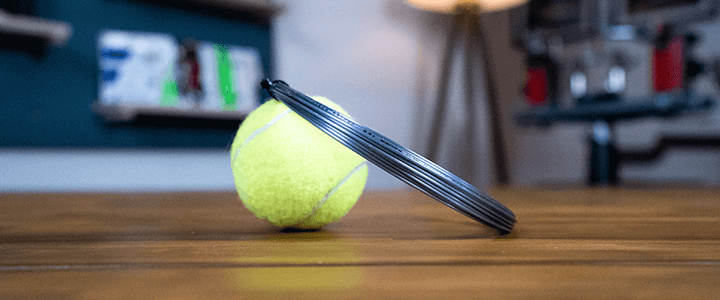
There’s no denying that polyester tennis strings are incredibly popular, but what makes them a highly sought after string? Let’s take a look at why professional to recreational players gravitate toward poly.
Topspin
If there’s one professional tennis player in the past two decades that we can credit with the rise in popularity of polyester tennis strings, it would be Rafael Nadal. He has redefined what’s possible when it comes to topspin, and not surprisingly, he strings his racquet with a full bed of polyester.
Polyester strings are perfect for topspin because of two key factors:
- Low power
- Elasticity
First, polyester offers very little power. As a result, players can swing faster without the ball sailing long, which subsequently influences the amount of topspin a player can generate. Racquet head speed is the primary contributor to topspin.
Additionally, polyester strings are smooth, resilient, and quickly snap back into place. As a result, this snapback effect has the potential to increase spin, which is often a goal for players of all levels.
However, there’s one caveat. To benefit from the increased spin potential of poly strings, a player needs to have the appropriate technique and sufficient racquet head speed.
Assuming an appropriate grip is in use, higher racquet head speeds increase topspin and cause these strings to move out of place or deform and subsequently snap back into place. Unfortunately, if your racquet head speed isn’t high enough, you won’t see drastic increases in spin, which is worth considering as you evaluate polys.
Due to his immense racquet head speed, Nadal’s style of play is well suited for polyester tennis strings.
With that said, if you’re looking to amp up your spin, polyester tennis strings are an excellent option that comes with other benefits, too.
Control
In many ways, spin and control go hand in hand. If you hit with more topspin, you can hit higher over the net and increase your margin for error while still having confidence that the ball will drop back down into the court. As a result, the added spin gives players a greater sense of control.
However, the main reason polyester tennis strings provide players with more control lies in the inherent stiffness of the string. This stiffness results in less power, but it also causes the ball to sit on the string bed for a shorter period – referred to as dwell time.
The shorter dwell time ultimately provides players with a more consistent response from their strings. That, in turn, gives players a greater sense of control.
Today, players are stronger than ever, and their style or approach to the game has become increasingly aggressive. This change has put a premium on control, so it’s no wonder that more players have turned to polyester to provide the control they desire.
Durability
When polyester tennis strings first emerged on the market, one of their top qualities was durability, or their ability to withstand breakage. Not surprisingly, polys have maintained this quality over the years.
At the time, this was a welcome attribute for big hitters and chronic string breakers. After all, breaking strings can become an expensive habit. Moreover, it can cost you a point, game, or match when it happens at the wrong time.
So, if you’re looking for a string that will stand up to your aggressive style of play, then polys might be a great option.
While we’re on the topic, it’s important to distinguish between durability and a string’s ability to keep their tension, which players often mistake as the same. The truth is, tension maintenance, or how long the string keeps its tension, is one of polyester strings’ biggest pitfalls.
We’ll cover this more in the disadvantages section of this article.
String Movement
One of the lesser-praised qualities of polyester strings is that they virtually always snap right back into place.
You might be wondering, why should I care about string movement? If so, that’s a great question.
The first and most significant reason you might care about string movement goes back to control and your stringbed’s ability to provide a consistent hitting surface. Theoretically, the more consistent your hitting surface, the more control you’ll have.
Beyond control, some players simply can’t stand having to readjust their strings between every point. If this isn’t a problem for you, then perhaps you wouldn’t consider it an advantage, but it’s worth noting.
Poly Disadvantages
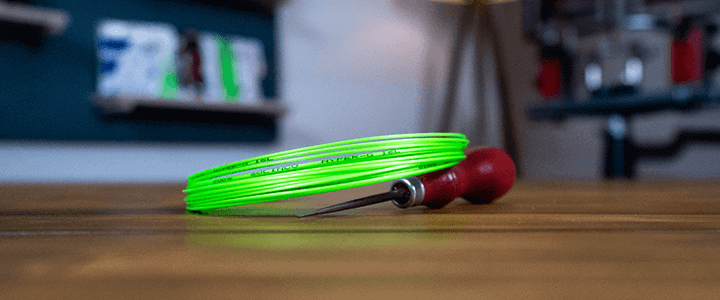
If polyester tennis strings are starting to feel too good to be true, then it’s about time we switch over to their weaknesses and the common complaints associated with them.
Comfort
One of the most significant drawbacks to polyester strings is that they’re stiff, making them feel uncomfortable. If you’re young and healthy, then you might not think twice about comfort.
However, as any player who has ever had tennis elbow can attest, it doesn’t take much when playing to add to their discomfort.
For this reason, polys have often been labeled as harsh, especially when compared with other strings like natural gut or multifilament.
However, there are a few different schools of thought regarding the harshness of polyester strings, with some individuals arguing the harsh feel experienced by players is a direct result of stringing at higher tensions. We’ll cover tension at a later point in this article.
Tension Maintenance
Another pitfall of polys lies in the fact that they’re not great at maintaining their tension over long periods. This tension loss occurs at a faster rate than other types of strings, both while you’re playing and while your racquet sits in your bag.
This tension loss can be problematic for a few different reasons. First, and perhaps most importantly for recreational tennis players, is that your strings are going to go dead faster, which means you’re going to have to replace them more frequently. That means you’ll be spending more to keep your racquet strung.
However, dead strings will also lead to less control, power, and comfort, which, if not replaced, can contribute to arm injuries like tennis elbow. Combined with the stiff nature of polys, it can make the problem worse.
Poly vs. Co-Poly

In recent years, the term co-poly has emerged and confused players.
If we take a step back, polyester tennis strings have historically used a monofilament construction. This type of construction means they’re composed of a single solid strand made from one plastic or polymer such as polyethylene terephthalate or PET.
With that in mind, the term co-poly starts to make a lot more sense because co-polys are simply polyester tennis strings that combine additives to enhance their performance.
As you can imagine, manufacturers are experimenting with co-polys in an attempt to maintain the advantages we’ve discussed while combating their disadvantages.
Another way to look at this is that polys and co-polys are both in the polyester family, so there’s nothing wrong with referring to co-polys as polyester strings.
Soft Polys
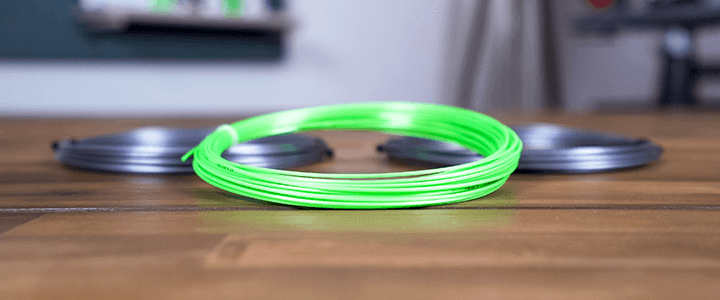
One of the biggest complaints about polyester tennis strings is their lack of comfort, so some string makers have introduced softer polys to improve comfort while maintaining the core performance characteristics you’d expect from this type of string.
However, it’s important to keep the promise of these strings in perspective. Although they improve comfort relative to other polys, they’re still stiff with similar pros and cons that you’d find with any polyester string.
In fact, softer polys often struggle more when it comes to tension loss and performance longevity, so you’ll want to keep in mind with this type of string.
Stringing with Polys
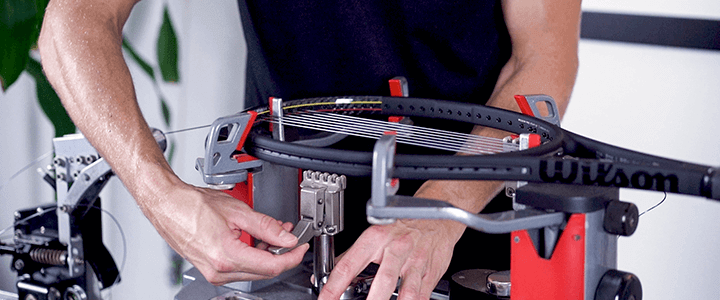
If you’ve decided that you’d like to experiment with polyester tennis strings, then you might be asking yourself these questions:
- What tension should I use?
- Which gauge is the best?
- If I’m stringing them as a hybrid, should I use them in the mains or the crosses?
- When should I replace my polyester strings?
Let’s dive into each of these topics.
Tension
Starting with string tension, if you’re moving from natural gut, synthetic gut, or a multifilament, then I’d recommend you drop the tension for your polyester string by 5-10 percent.
Therefore, if you typically string your racquet at 55 pounds with a multifilament, then you’re going to want to string 3-5 pounds lower, or anywhere between 50 and 52 pounds.
That kind of tension drop might make many players a bit nervous, with the most common fear being the loss of control, so let’s talk about why I’d recommend the drop in tension.
First and foremost, it’s important to remember that polyester strings are stiffer than other strings. If you string too high, you’re going to enhance the strings’ harsh feel, especially compared with your current non-poly string. Bringing the tension down a bit will help reduce the stiff, uncomfortable feel associated with polys.
Similarly, if you string too high, you’re going to decrease the strings’ power potential further to the point where you may end up feeling like the strings are dead. Since polyester strings are naturally more control-oriented, you can drop the tension while still maintaining excellent control but allowing the strings to feel lively.
Gauge
A tennis string’s gauge represents its thickness, ranging from 19 to 15, with lower numbers referencing thicker strings. More specifically, strings range from 1 to 1.5 millimeters in thickness.
The thicker the string, the more durable it will be, while thinner strings will offer more topspin. Since polyester strings are more durable, many players will opt for a slightly higher gauge to enhance topspin and feel.
If you’re unsure where to start, then stringing one step down from what you use for synthetic gut or a multifilament should do the trick. Of course, there’s nothing wrong with maintaining your existing gauge.
Hybrid – Mains or Crosses
If you opt to use a polyester string as part of a hybrid setup, then you may be wondering whether or not you should use the poly in the mains or the crosses. It’s a fantastic question!
The string you place in the mains will tend to dominate the overall feel of your racquet, so you’ll need to ask yourself which string characteristics are most important to you.
For example, many players who use multifilament will be interested in experimenting with a hybrid setup, but they might be wary of the harshness associated with polys. If that’s you, then you might opt to keep the multifilament in the mains and then string the crosses with polyester.
On the other hand, if you’re looking to maximize topspin and durability without completely giving up the pop of your multifilament, then you might string the polyester in the mains and the multifilament in the crosses.
Again, it all comes back to your personal preferences, along with the specific characteristics of the two strings you opt to bundle for your hybrid string setup.
Replacing Polyester Strings
As your strings wear, they’ll begin to form notches at the intersections. These are helpful to keep an eye on because as they get deeper, they’ll be more likely to break.
However, beyond visual indicators, if you begin to notice a drop in the control, spin, power, or the comfort of your strings, it may also be time to replace them.
The duration or length of time that passes between string jobs will vary widely from player to player and depend on various factors, including frequency and duration of play, style of play, skill level, string choice, racquet, and more.
For a deep dive on this topic, check out our guide on replacing tennis strings.
Hybrid Poly Setups

Many players appreciate the benefits of polyester, but the disadvantages prevent them from stringing their entire racquet with them. Perhaps they’ve tested a full bed of polyester, and it’s too harsh on their arm, or it doesn’t provide enough power.
Luckily these players don’t have to settle for an all-or-nothing approach. Instead, they can combine two different styles of strings, such as polyester and a multifilament, to try and get the best of both worlds.
While stringing entirely with polyester tennis strings has become a widespread practice on the pro tour, stringing with polyester and natural gut or a multifilament is extremely common as well.
Here’s a quick recap of the pros and cons of polyester:
Pros
- Spin
- Control
- Durability
- Limited string movement
Cons
- Tension maintenance
- Comfort
For comparison, here are some pros and cons of nylon multifilaments:
Pros
- Power
- Comfort
- Tension maintenance
Cons
- Spin
- Control
- Durability
- String movement
As you look through the pros and cons associated with each string, you can begin to understand why it would be highly compelling for a player to want to combine the two.
Helpful Tip
Keep in mind that the above pros and cons are generalities for these types of strings based on how they tend to score in playtests.
Who Should Use Polys?
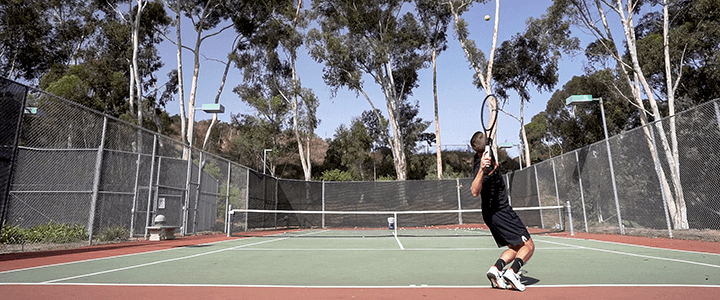
At this point, you may be wondering whether or not you should test a set of polyester tennis strings. If any of the advantages are appealing to you, then you should consider them.
I’d even encourage players who don’t think they’d be a great fit to experiment with them because you won’t know whether or not you like them without giving them a try.
Before you jump in, let’s take a look at three questions you can ask yourself to help determine whether you should stay away from polys.
Do you have the technique?
One of the most frequent reasons players will seek out polyester tennis strings is greater topspin potential. While it’s true that polys will help maximize your spin, there is no substitute for proper technique, which is a requirement to get the most out of the string.
As a beginner, you’ll see huge gains in topspin by improving your technique and likely see virtually no increase in spin by merely having your tennis racquet strung with polyester.
However, once your technique, along with your racquet head speed, is sufficient, you’ll be able to give the topspin on your shots an added boost when you string your racquet with polyester.
Most players who reach an intermediate level will find themselves in a position to begin benefiting from this type of string.
Do you have any arm injuries?
If you’re suffering from any arm injuries like tennis elbow, then it’s unlikely that you’re going to enjoy polyester strings.
Remember, polyester is a solid hard plastic that is stiffer than other materials and string constructions like multifilament. As a result, you’ll find your arm absorbs more shock from your shots, and because they don’t deliver much power, you’ll have to work harder to achieve the pace that you desire.
Also, polyester tennis strings will lose their tension and go dead faster. If you’re not diligent about restringing, then you’re going to magnify the adverse effects, as you have to work even harder to hit with power.
At the very minimum, I’d encourage players in this situation to string a poly as a hybrid with another high-comfort string.
Do you have the budget?
Again, since polyester tennis strings don’t do as great a job at holding their tension, they’ll go dead faster than other strings, which means you’ll have to restring more frequently.
Of course, every time you restring, it’s going to cost you, so you’ll want to make sure you’re comfortable with the added expense because it can start to add up.
Do you recommend polys for kids?
The health and longevity of kids playing tennis are of utmost importance, so I usually encourage parents to steer clear of polyester strings to prevent injury.
Of course, every child’s development will differ, but for most, I wouldn’t recommend introducing them any earlier than age 16 with a strong intermediate to advanced skill level.
Best Polyester Strings
Here’s a selection of a few of our favorite polys.
Best Overall

Our pick for the best polyester tennis string is Luxilon ALU Power, which has dominated much of the market since its introduction.
It’s often the measuring stick for comparing all other polys. Although it’s not a string for everyone, it perfectly exhibits the characteristics of control, durability, spin, and feel that players expect.
Compared to other top polyester tennis strings, the area where ALU Power shines for us is the feel it offers. Although one of the most subjective qualities, it’s why we give it our top pick.
Best for Spin

When it comes to maximum topspin, look no further than Babolat RPM Blast, which Rafael Nadal uses.
As with all polyester, your racquet head speed will be the primary factor determining topspin with your string providing incremental benefit. If you used other polys, you’re sure to notice a difference.
Best for Durability
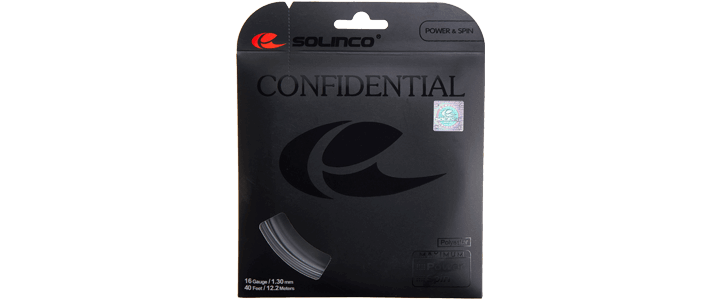
Durability is a defining characteristic for polyester strings, but some do the job better than others.
New in 2020, Solinco Confidential is by far one of the most durable polyesters on the market. However, what makes this string unique is its exceptional all-around performance.
Best for Control

A string that has low power, delivers exceptional spin, and excellent feel will nearly always score high in the control department.
Although there are a handful of polyester strings that fit the bill, Solinco Hyper-G is about as good as it gets in this category.
Best for Power
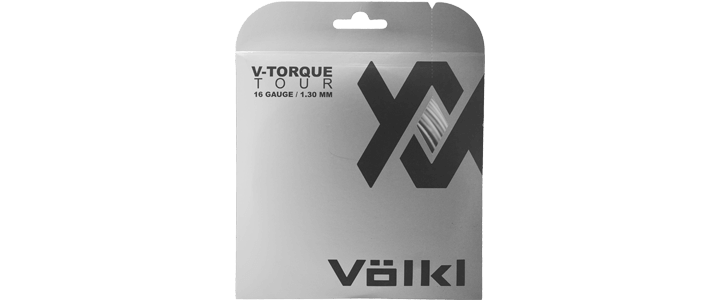
Polyester tennis strings are not known for their power, but some polyester strings offer more pop than others.
Our pick for the most powerful poly is Volkl V-Torque Tour, another string we’d recommend for topspin.
Best for Comfort

Like power, comfort is not exactly what comes to mind when you think about polyester. However, there are a few out there that will surprise.
One string that’s higher on our list of comfort-oriented polyester tennis strings is Head Sonic Pro Edge.
Helpful Tip
A more practical route that we’d recommend if you’re suffering from any discomfort in your arm is a hybrid setup. In that case, Head Sonic Pro Edge would make an even better fit to achieve higher comfort levels.
Best for Small Budgets

Volkl Cyclone is one of our all-time favorite polyesters, which delivers exceptional performance in all areas you’d expect.
However, its affordable price relative to many other strings make it a standout that’s hard to pass up and well worth giving a try.
Best for Soft Polys

Hyper-G is an impressive polyester tennis string, so when Solinco released Hyper-G Soft, we were excited to give it a try.
Needless to say, it does not disappoint. If you’re looking for a more comfort-oriented polyester tennis string that doesn’t give up too much in other areas of performance, you’ll enjoy Hyper-G Soft.
Which Pro Tennis Players Use Polys?
The vast majority of professional tennis players use polyester tennis strings. In fact, players that don’t have become the exception. However, they’re frequently in use as part of a hybrid string setup.
Here’s a selection of a few of the top players and their string setups – a big shout out to Colin Triplow, who shared these with the community.
| Racquet | Tension Range |
| Roger Federer | Main: Wilson Natural Gut Cross: Luxilon Alu Power Rough |
| Novak Djokovic | Main: Babolat VS Team Cross: Luxilon Alu Power Rough |
| Rafael Nadal | Main: Babolat RPM Blast Cross: Babolat RPM Blast |
| Andy Murray | Main: Luxilon Alu Power Rough Cross: Babolat VS Touch |
| J. Martin del Potro | Main: Luxilon Alu Power Cross: Luxilon Alu Power |
| John Isner | Main: Wilson Natural Gut Cross: Tecnifibre Pro RedCode |
| Nick Kyrgios | Main: Wilson Natural Gut Cross: Yonex Poly Tour Pro |
| Richard Gasquet | Main: Luxilon Big Banger Original Cross: Luxilon Big Banger Original |
| Serena Williams | Main: Luxilon 4G Cross: Luxilon 4G |
| Venus Williams | Main: Luxilon 4G Cross: Luxilon 4G |
| Simona Halep | Main: Luxilon Alu Power Cross: Luxilon Alu Power |
| Angelique Kerber | Main: Yonex Poly Tour Fire Cross: Yonex Poly Tour Fire |
| Caroline Wozniacki | Main: Babolat RPM Dual Cross: Babolat VS Touch |
| Sabine Lisicki | Main: Yonex Poly Tour Spin Cross: Prince Natural Gut |
| Johanna Konta | Main: Babolat VS Touch Cross: Babolat RPM Blast |
| Petra Kvitova | Main: Luxilon Alu Power Cross: Luxilon Alu Power |
The Future of Polys
While polys have come a long way, there’s no doubt that manufacturers will continue to push the boundaries of what’s possible with this popular type of string.
Most likely, we’ll continue to see experimentation with co-polys and the introduction of new additives that attempt to maintain the advantages of the string while minimizing the disadvantages.
One thing is for sure: Polyester tennis strings will remain hugely popular and likely achieve further market share as the strings evolve to meet the growing demand from players of all levels.
Common Questions
Here are a few common questions we get about polyester tennis strings.
How long do polyester tennis strings last?
Many factors can influence how long a polyester string will maintain tension, including the type of polyester. However, it’s safe to say that polyester strings will perform well for 10-20 hours of play.
What’s the difference between polyester and nylon tennis strings?
Polyester and nylon are the two most popular materials used to create synthetic tennis strings.
Polyester strings are commonly used by intermediate to advanced tennis players looking for a low powered option with enhanced spin, control, and durability. On the other hand, players of all ages and levels use nylon strings, which offer power, comfort, and feel.
There is a wide range of quality available for both types of strings, which will give you more or less or the attributes described for each. Players frequently combine polyester and nylon as part of a hybrid string setup.
Are polyester tennis strings good?
Yes, polyester tennis strings are fantastic for players looking for spin, control, and durability. However, they’re not for everyone because they’re also low powered, lack comfort, and typically require frequent restringing because they don’t hold their tension as well.
Wrapping Up
Hopefully, this article proves to be useful in providing you with a deeper understanding of polyester tennis strings. Of course, if you have questions, please let us know in the comments below.
We’d also love to hear any of your experiences with polys that you might like to share with other readers!
Play Better Tennis
Improve your game alongside our community of tennis players
Why join?
Discussion Boards
Join the conversation with other members of the community.
5 Point Friday
Read our weekly recap of the 5 most interesting things we dig up in tennis.
Trackbacks & Pingbacks
Leave a Reply
Want to join the discussion?Feel free to contribute!



Fantastic article
Thanks, John!
I’ve been stringing for only two years, and I’ve learned some lessons along the way as I’ve reached out to seasoned stringers with questions. They’ve often referenced terminology that was foreign to me, but at that point I wasn’t “ready” for their depth of information. Today as I’m preparing to string two racquets, I had some set-up questions and was fortunate to find this article. It’s just what I needed, and my knowledge base is finally ready to accept and absorb what was said. I appreciate what you’ve put into it, and I also benefited from the links to other articles that were embedded in your piece (ex: string gauge).
That’s awesome, Kelly. Great to hear you’re finding some clarity and that this guide helped you along in the process.
Thanks for taking the time to say hello!
All the best,
Jon
Very Well explained. Good Job!
Thank you, Hammad!
Great article, thank you!
Much appreciate, Pete. Thanks for the positive vibes :)
Great synopsis. Thanks!
Thanks, Joe! Glad you enjoyed it.
Great guide. It sure helps deciding if polys can be a good addition to my game and which combination adjust to my needs. I find myself an anomaly but would like to share my experience anyways in case it might help others: I prefer a full bed of poly at high tension ( 57 to 60) in a control oriented racket (Head Prestige MP). It provides me confidence to hit out and take the ball early without fear of over hitting. I usually play three times a week and restring every 3 months. I prefer Kirschbaum Max Power 18 or Luxilon Alu Power 16L. I do not experience arm discomfort. Keep the good job!
Hi Eric! I appreciate you taking the time to share your experience with polys and glad you found the article helpful. I’m sure others will find your experience useful to consider. I don’t string quite as high, but I also prefer a bit higher tension than many players who push the lower boundaries of tension with this particular type of string. Good stuff, and thanks again for the pos!